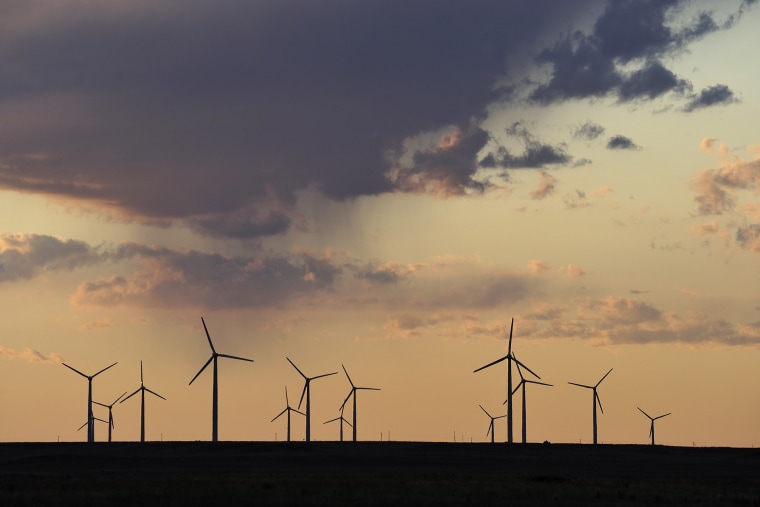At the beginning of this month, the Environmental Protection Agency (EPA) proposed a strategy to cut power plant emissions by 30% across the entire country. If the rule is implemented in anything resembling its present form, it will have a dramatic effect on U.S. energy policy across the entire country. Yet not all states will share in the consequences equally.
In part, that's because some states have already gotten a head start on reducing carbon emissions. Several northeastern states, for example, have banded together under the Regional Greenhouse Gas Initiative (RGGI), in an effort to cut pollution region-wide. Other states have acted unilaterally, with Colorado appearing particularly well-positioned to meet new emissions standards.
"Colorado will be able to use many of the things included in their existing strategy -- such as renewable energy and energy efficiency programs -- to help comply with the new proposed requirements," said an EPA spokesperson in an email to msnbc.
In the text of its proposed rule [PDF], the EPA held up Colorado's 2010 Clean Air, Clean Jobs Act as a positive example on no less than three separate occasions. That legislation, the centerpiece of the state's current anti-pollution strategy, required two utility companies in the state to come up with plans to reduce emissions. When the bill was first introduced in March 2010, a statement from then-Gov. Bill Ritter hailed it as "a national model for reducing air pollution."
“The Clean Air-Clean Jobs Act will dramatically reduce air pollution and support the growth of homegrown energy, ensuring that cleaner-burning Colorado natural gas works together with renewable energy to keep building our nationally recognized New Energy Economy,” said Ritter in the statement.
Four years later, with tighter emissions standards on the way, that praise appears to have been vindicated. Xcel Energy, the state's largest utility company, says it is on track to reduce its emission to roughly 30% below 2005 levels by 2020. And by various measures, Colorado consistently ranks in the top ten U.S. states when it comes to wind and solar power generation. As a result, the state is in "a good position" to meet new EPA standards, Colorado Energy Office official Neal Kemkar recently told The Denver Post.
Although the Clean Air, Clean Jobs Act was an act of the Colorado state legislature, the impetus for the bill came from Washington The federal Clean Air Act required Colorado to either come up with a satisfactory plan for combating air pollution or submit to a plan drafted by the EPA. A bipartisan majority in the state legislature opted for the former approach when it approved the Clean Air, Clean Jobs Act. Martha Rudolph, the director of Environmental Programs for Colorado's Department of Public Health and Environment, said the bill enjoyed broad support because of how many institutions got to leave their imprint on the final language.
"It was the result of negotiations between a number of different stakeholder groups: The natural gas industry, environmental groups, legislators, and Xcel Energy, which is our largest energy utility in the state," Rudolph told msnbc.
The stated purpose of the final bill "was not, strictly speaking, to reduce greenhouse gases," according to Rudolph. Instead, it was an attempt to combat "regional haze," or air pollution which impedes visibility. It just so happens that the best way to cut back on that haze and improve immediate air quality was to scale back on some of the emissions which also corrode the ozone layer.
As a result of the bill, Xcel Energy and the smaller utility Black Hills Energy were both required to submit plans for scaling back their emissions to the state Public Utilities Commission. Xcel's plan, which was approved before the end of 2010, required that the company shut down six different coal-fired units at three different power plants across the state. The utility company is also transitioning to a greater reliance on natural gas and solar power.
"I think that having this mixed energy portfolio is a good thing," said Rudolph. "We're always going to be looking at ways of reducing emissions and reducing greenhouse gas emissions. That's always important to us, but what we have to do it in a thoughtful way that does protect our jobs."
The reference to a mixed energy portfolio echoes the White House's commitment to an "all-of-the-above" energy strategy. Environmental activists haven't often criticized that approach; on at least one occasion, 350.org's Jamie Henn has compared it to "an 'all of the above' diet." Yet the local green group Environment Colorado stands behind the state's record.
“By using energy more efficiently, and by generating more power from clean, renewable sources, we are delivering a one-two punch in the fight against global warming,” said Kim Stevens, the group's campaign director, in a recent statement. “We’ve proven that we have what it takes to protect our children and future generations from the worst impacts of climate change."
Both state officials and Xcel employees are currently reviewing the proposed EPA rule. Rudolph expressed some misgivings to msnbc about the current language, saying she is not yet sure whether the EPA has "given Colorado or other states the full credit we think we should get" for already cutting emissions. As the emissions rule goes through its public comment period, it is possible that various states will see the CO2 targets relaxed or tightened.
"We continue evaluate EPA’s complex proposal and will work with our regulators, our states, customers and the environmental community to help shape the final rule," said Xcel spokesperson Gabriel Romero over email. "Our objective is to achieve a rule that supports Xcel Energy’s ability to provide the reliable, affordable power customers need, in a way that is cleaner for the environment.”
CORRECTION: An earlier version of this article said that Xcel was on track to reduce its emissions to 30% below 2010 levels. In fact, the target is 30% below 2005 levels.
